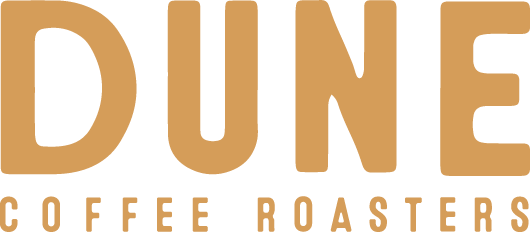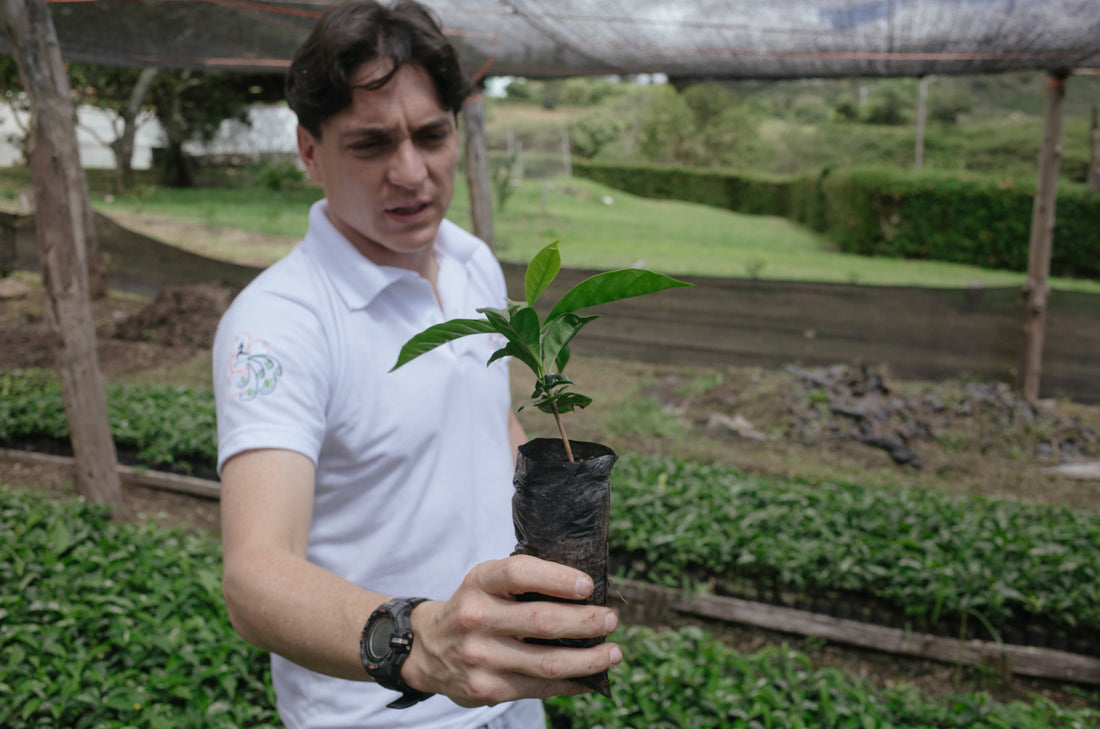I still remember tasting Juan Peña’s coffee for the first time. It was sometime early in the year, in preparation for the 2018 United States Barista Championship. I was working a shift at our State St cafe, and we had a cupping planned for later in the afternoon to taste through another set of coffees as potential candidates to use for competition.
Our friends at Cafe Imports, knowing that I was competing, sent us some coffees they were excited about - all really special coffees. We set up a table of six or so samples, all blind, and we began tasting.
I don’t remember which cup it was, but I remember where the cup was on the table - closest to our roastery, facing the garage door in the lab. I took my first sip, and involuntarily looked up, and around at everyone. “Where did this Ethiopia come from?” “What is this coffee?”
That coffee happened to be not from Ethiopia, but from Ecuador - a washed Typica from Juan Peña, and his farm Hacienda La Papaya. Incredibly floral, tropical, bursting with fresh fruit, and flavors that I had never experienced from an Ecuadorian coffee before, we all made the decision to move forward with that coffee.

After an enormously unexpected success in competition, with our team taking third place in the barista championship, Cafe Imports reached out and asked if I would be interested in accompanying Cole McBride, who had placed first also using coffee from Hacienda La Papaya, to visit Juan’s farm. As my first origin trip, it was everything I could have hoped for, from experiencing Juan’s production first-hand, the hospitality we received, and the excitement of seeing the coffees we would continue to taste as a result of this new relationship.
This past year, both Felix and myself competed with Juan’s coffee - this time, a naturally processed Typica (both of us were excited to hear that Juan’s favorite coffee this year was the same one we were serving in competition). The experience of working together with the same coffee, within two different contexts of Felix preparing for brewer’s cup and myself having a second go at barista competition, really instilled an appreciation for what Juan was doing, and the potential for flavor in the coffees his team was producing.

In early August, Juan invited Cole, Felix, and myself back to Hacienda La Papaya to prepare for another year of competition, and to see the progress happening on the farm. We flew into the capital city of Quito, barely getting adjusted to the elevation before we took a redeye flight into Cuenca, where Juan met us at the airport before driving into Saraguro.
Once we arrived at Hacienda La Papaya, Felix set to brewing coffee on his custom 3D-printed brewers he had developed for the brewer's cup competition - double walled, flat bottom, with a lid to promote higher temperatures. All of the coffees we tasted during our stay were roasted on an Ikawa sample roaster, which Juan uses for quality control and to taste the coffees he is producing. Rather than having to wait until roasters receive his coffees, he is able to taste his own coffees as he is producing them, and have a direct line of feedback with people working with his coffees.

The next morning, Juan took us up the slopes of his farm, where his coffee trees are planted along a west-facing hillside. His farm manager, Jaime, as well as Juan Andres, an agronomy student at the University of Cuenca, came along to help us with demonstrations and show us the systems on the farm. Jaime was also sporting a one-of-a-kind jersey that Juan had made for the Hacienda La Papaya team, highlighting all of the achievements that Juan and his coffees had achieved (it’s a pretty strange feeling seeing someone wearing a shirt with your name on it!).

Upwards of 6000 feet above sea level are some of Juan’s newly planted coffee trees, an area which he terms “New Papaya”. This is where Sidra and Gesha trees are planted, in an area with good sun exposure and carefully irrigated to the same exacting fertilization requirements as the rest of the farm. Some of these coffee trees were barely at waist level the last time I had visited, and they were five feet tall this time around!

One of the many reasons I admire Juan and the work he is doing is that he believes that when everyone succeeds, he succeeds. Many of the neighboring coffee producers in the region had been planting lower quality, higher yielding coffee trees, at the behest of the local government. However, when these trees began bearing fruit, the producers were unable to find a buyer for these coffees, partly due to the lower cup quality of their harvests.
Juan has been working with these producers, supplying them with fertilization formulas that he has been testing on his farm, and advocating that growing specialty coffee is beneficial not only for us as consumers, but for the financial wellbeing of these farmers.
We began some of our planned experiments in earnest that same day. In order for us as a team to bring some truly exceptional coffees forth for competition, as well as to push the limits of what we have been doing, Juan suggested we try some less orthodox processing methods on the coffees he was producing this year. This ranged from natural processing, in which ripe coffee cherries are allowed to carefully dry in the fruit, bolstering fruity and complex characteristics, all the way to carbonic maceration, a winemaking technique in which the cherries begin fermentation in an oxygen-free environment, forcing all of the flavors back into the coffee. Juan Andres proudly showed us a homemade stainless steel tank for our experiments, emblazoned with the La Papaya peacock logo.


In a rigorous procedure, Juan led us in experiment after experiment, changing one variable each time to produce an individual lot of coffee. These lots were tiny in terms of production lots, which can be hundreds of pounds, but would serve to inform us on what we thought tasted the best, and which processing method we could move forward with for competition and Juan’s future coffees.

Every morning after breakfast, we would converge in the main room on the farm to cup and score coffees that Juan had prepared. One morning, it was a table of the same Typica variety, with the only difference between the cups being a different ratio of compounds used in fertilization. Another day, it was a mixed table of coffees from Juan’s farm, as well as neighboring producers and even some of Juan’s employees! Felix and I especially loved some of these coffees. I remember being nervous at how high I was scoring some of these coffees, and I felt better when Felix shared some high scores as well.
It wasn’t all work - we also made time to enjoy ourselves as well. Felix took after Juan’s children and set the fastest time on this toy car from the drying rooms on the hill, down to the entrance of the farm. Juan also took us up to the waterfall that feeds La Papaya and all the neighboring farms, which was at almost 7000 feet above sea level!



One of my favorite moments was when Felix asked Juan if he could brew coffee for the employees on the farm. Felix put on a full brewer’s cup presentation in Spanish for Ilda, Maria, Jaime, and Segundo, showing them what competition entailed, how he was brewing the coffee, and talking them through tasting the coffees they were producing.

Slowly but surely, we began to see how our experiments were coming along, even though we wouldn’t be able to taste the coffees on our trip. All of the coffees we helped process would be on the drying beds, and Juan explained he would send us samples for us to taste back at home.



On the last day of our trip before we left for Quito, Juan took us to Cuenca to show us Cafexporto, the new dry mill and exporting facility he has been building to prepare and export coffees. This was a truly exciting prospect for us, because up until this time, Juan has been relying on other mills to prepare and store his coffee. Now, Juan will have full control over the storage and processing of not only his coffees, but the coffees of neighboring producers as well.

The warehouse stores bags and bags of Grainpro-lined coffees, as well as a cupping lab upstairs, and an office for all of the administrative work that Hacienda La Papaya requires, including 90 Puntos (90 Points), the fertilization program, and Cafexporto, the dry mill itself.
It was hard to say goodbye at the airport, especially after being treated to such gracious hospitality from Juan, his entire family, and all of the employees at La Papaya. At the same time, I think all of us were excited about the work we had been able to do together, for the coffees we would be tasting in the near future, for the coffees we would get to share through competition, and indeed, for what the future holds for us and Hacienda La Papaya.
*Special thanks to Cafe Imports for building this relationship between Dune and Hacienda La Papaya, to Cole McBride for working together on these coffees, to Felix for translating and speaking twice as much per day, and to Juan Peña, his family, Juan Andres, Jaime, Segundo, Ilda, and Maria for the incredible work they’re doing, and for the coffees they allow us to enjoy.



1 comment
Great post!!Always so happy to see people connecting at origin and building relationships! Looking forward to serving your sweet beans in Colorado!